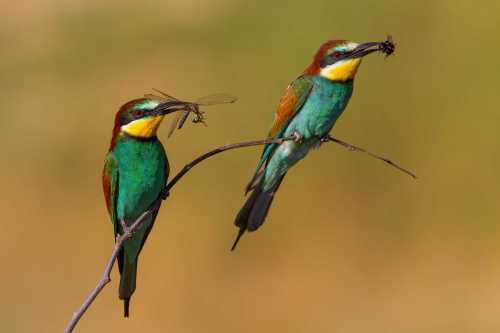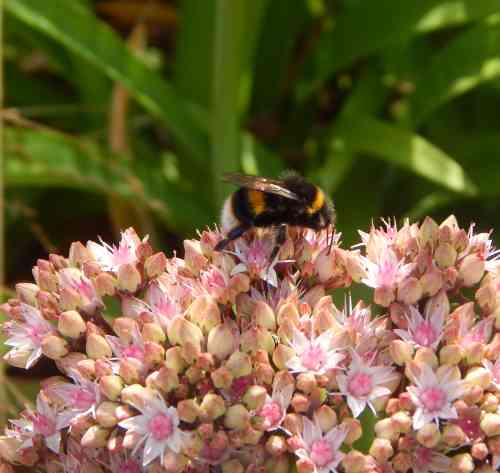What Do Bees Eat?
Updated: December 2023
What
do bees eat and drink? Do bees only eat nectar from flowers? Do bees
eat honey? Do all bees eat pollen, or are they doing
something else with it? What about the
diets of queen bees?
These are the kinds
of questions I am asked, so let’s set about answering these
questions and more.
Bees mostly eat and drink pollen and nectar from flowers, but
there are some differences in bee diets depending on the age of the bee and species.
Pollen (mixed with a little nectar) is often stored as food for larvae and deposited in the individual egg cells of solitary species, such as leafcutters and mason bees.
Why do bees eat pollen and nectar?
Pollen is a rich source of protein for bees, whilst the sweet nectar provides
energy and also helps to maintain water balance in the diet.

Do bees only eat nectar and pollen?
Mostly, we think of bees feeding from the flowers of herbs, cottage garden plants, trees and shrubs, however, there are a few exceptions and bees will sometimes find food elsewhere.
For example, bees may eat the sweet secretions of other insects, notably aphid honeydew - see below.
Honey bees have been noted to eat over-ripe fruit, and will sometimes eat the sweet secretions from extra-floral nectaries found on the green leaves of plants and shrubs.
There are also bees that eat meat.
Are bees vegetarian or vegan?
It is generally stated that bees are vegetarian and vegan with only a few exceptions. However, more recently, this has been debated, and some scientists argue that bees are in fact omnivores.
What do bumble bees eat?
Adults mostly eat nectar with a little pollen, though queens may consume more pollen, at least initially.

Queen bumble bee species emerge from their winter snooze, and the first thing they must do is find food to replenish their energy levels and
sustain them as they establish their colonies. Nectar will provide lots of energy, and pollen will provide a rich source of protein.
Bumble bee larvae initially eat pollen the
queen has stored for them, but as they grow and develop, they eat regurgitated
nectar and pollen fed to them by the queen and fully grown adult workers.
Read about the life cycle of bumble bees.
Do honey bees eat honey? What do bees eat in winter?

The main diet of adult honey bees is nectar and pollen. Larvae are fed royal jelly which is a protein-rich secretion made by young worker bees. It comes from the hypopharyngeal glands, which are a pair of long glands coiled in the sides of the head.
The amount fed to the larvae depends on their future role in the colony. Grubs destined to become workers are fed bee bread (a substance
made from honey and pollen) and just a little royal jelly, whereas those
destined to become queens will be fed only on royal jelly. Drones (males)
are fed a little more of this special food than workers.
Honey is nectar stored by honey bees in wax honeycombs, that has undergone a process to turn it into honey. The honey is then intended to feed the colony through the winter when fewer flowers are available for food, and weather hinders bees from going out to forage.
See: why bees make honey.
(Note that bumble bees do not store honey for winter as honey bees do. I discuss elsewhere the question of whether bumble bees make and eat honey).
Bees kept by beekeepers may at times be fed sugar. You can read more about that why beekeepers feed sugar to bees.
Do bees eat honeydew?
You may have heard of honeydew honey.
Honeydew is a sugar-rich sticky liquid, secreted by aphids and some scale insects, as they feed on plant sap. When food is scarce, bees (that includes honey bees and bumble bees) may eat it as a substitute for nectar when foraging conditions are challenging, although it is believed to be not as nutritious.
Below is a wonderful photograph kindly sent to me by Valerie Nicolson. She says the honey bees are very active feeding on aphid honeydew on the underside of the leaves of her lime and lemon trees!
 Above: Honey bee feeding on aphid honeydew, by Valerie Nicolson.
Above: Honey bee feeding on aphid honeydew, by Valerie Nicolson.Thank you Valerie!
Common questions
Is nectar only found in flowers?
No, sometimes bees eat nectar from extra-floral nectaries found on leaves and stalks of plants. One year, I watched bumble bees feeding on extra-floral nectaries on the underside of green laurel leaves. I should point out that we were
in a forest, and at that particular time, there was little in flower. This is fairly common behavior, including among honey bees and wasps.
A tip for gardeners: as far as possible, try to select plants that provide flowers for pollinators around the seasons.
Do bees eat fruit?
As stated above, honey bees have certainly been observed to feed at very ripe
fruit, including apples, plums, grapes, peaches, and pears.
Do bees eat wood?
No, although I am aware that watching wood boring bees or
carpenter bees can lead people to ask the question.
 Burrows excavated into wood by
carpenter bees.
Burrows excavated into wood by
carpenter bees.Do bees eat meat? Do bees eat insects?
Although it is very uncommon, I am
certainly aware of a very small number of tropical species (notably
in Panama) which actually do this1! They are known as 'Vulture bees'. You can read more about this and watch a video on the link 'Do Bees Eat Meat?'.
 Trigona hypogea eating a dead lizard. Photograph by D. Wittman
Trigona hypogea eating a dead lizard. Photograph by D. WittmanThere are also records of bumble bees eating meat in Spain.
Why do bees eat dirt?
They don’t, however, some species -
typically mason bees do collect mud with which to help build their
nests cells, but they are not eating the mud.
Alternatively, it may also be possible that the bee species being observed is actually excavating a nest by burrowing a tunnel into the ground, but again, the bee is not actually eating the dirt.
References
1. Roubik DW. Obligate necrophagy in a social bee. Science. 1982 Sep 10;217(4564):1059-60. doi: 10.1126/science.217.4564.1059. PMID: 17839343.
Plus see links to other pages for more information.






